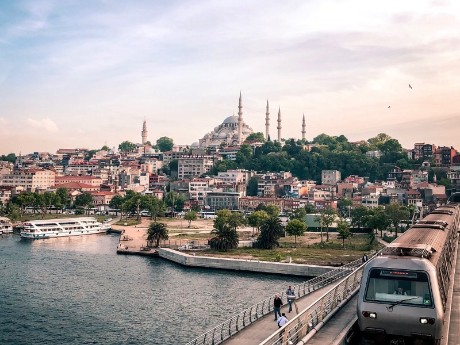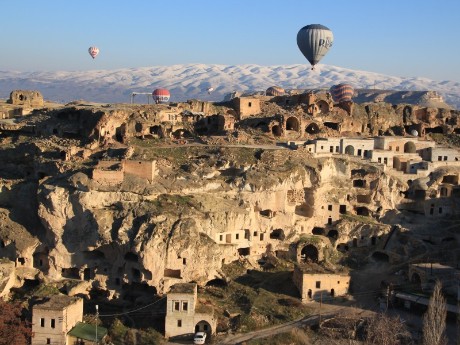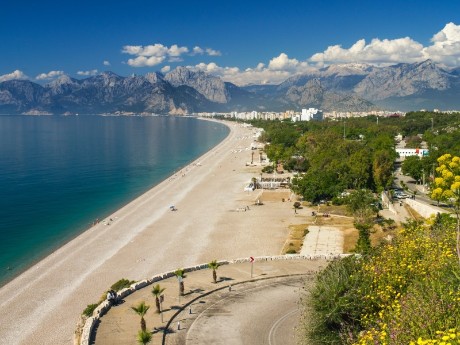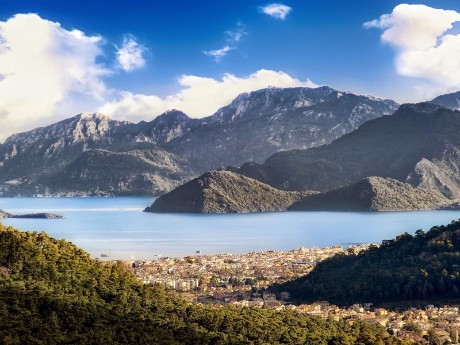Turkey: Istanbul, Cappadocia, Antalya, Marmaris
Travel on a mesmerizing Turkish journey, discovering the enchantment of Istanbul, Cappadocia, Antalya, and Marmaris. Istanbul, where East meets West, invites exploration of the iconic Hagia Sophia, the bustling Grand Bazaar, and the majestic Blue Mosque. Venture to Cappadocia, a surreal landscape of fairy chimneys and cave dwellings. Witness the sunrise from a hot air balloon and explore the unique underground cities. Continue your odyssey to Antalya, where history meets the Mediterranean.
Read more
Travel on a mesmerizing Turkish journey, discovering the enchantment of Istanbul, Cappadocia, Antalya, and Marmaris. Istanbul, where East meets West, invites exploration of the iconic Hagia Sophia, the bustling Grand Bazaar, and the majestic Blue Mosque. Venture to Cappadocia, a surreal landscape of fairy chimneys and cave dwellings. Witness the sunrise from a hot air balloon and explore the unique underground cities. Continue your odyssey to Antalya, where history meets the Mediterranean. Stroll through the ancient streets of Kaleiçi, relax on pristine beaches, and explore the fascinating Antalya Museum. Conclude your Turkish sojourn in Marmaris, a coastal paradise. Enjoy the vibrant nightlife, sail along the stunning coastline, and savor the local cuisine. This Turkish adventure promises an exquisite blend of history, natural wonders, and coastal beauty, creating indelible memories across the diverse landscapes of Istanbul, Cappadocia, Antalya, and Marmaris. Waterviews strives to offer accommodation options within walking distance of water and/or in an area of touristic interest. Our prices include taxes (but excludes local tourist taxes). Customize your trip to your personal preferences with optional activities (hit the “Add Activities’’) or change hotels, etc. Contact us for customization at no extra cost at: Service@waterviewstravel.com
Destinations
- Istanbul
- Cappadocia
- Antalya
- Marmaris
Itinerary
Istanbul

Once the capital of the Roman, Byzantine and Ottoman empires and straddling two continents on the banks of the Bosphorus strait, Istanbul is Turkey's historic, cultural and cosmopolitan jewel and dazzles with its vibrant atmosphere and incredible blend of old and new. Marvel at the minarets and frescoes of the grand Hagia Sophia and the Blue Mosque, shop for local wares and get lost in the Grand Bazaar and be sure to enjoy the city's diverse culinary and arts scene. With over 2,000 years of history, Istanbul is a must-see on any itinerary.
Read more
Once the capital of the Roman, Byzantine and Ottoman empires and straddling two continents on the banks of the Bosphorus strait, Istanbul is Turkey's historic, cultural and cosmopolitan jewel and dazzles with its vibrant atmosphere and incredible blend of old and new. Marvel at the minarets and frescoes of the grand Hagia Sophia and the Blue Mosque, shop for local wares and get lost in the Grand Bazaar and be sure to enjoy the city's diverse culinary and arts scene. With over 2,000 years of history, Istanbul is a must-see on any itinerary.
Additional Information
History
While relics of prehistoric human settlement were found in the Yarımburgaz Cave near the Küçükçekmece Lake and during the construction of a subway station in Yenikapı, Greek colonists from Megara, directed by their legendary leader Byzas, have been traditionally accepted as the founders of Istanbul. Expanding the ancient Greek colony of Byzantium by the order of the Roman Emperor Constantine the Great, the imperial city of Constantinople was for nearly a thousand years the heavily-fortified capital of the Eastern Roman (later termed Byzantine) Empire. To this day, the Ecumenical Patriarch, head of the Eastern Orthodox Church continues to be the Archbishop of Constantinople, who is still based in Istanbul. It was finally conquered by the Ottoman Sultan Mehmed II on 29 May 1453, an event sometimes used to mark the end of the Middle Ages. It was the nerve centre for military campaigns that were to enlarge the Ottoman Empire dramatically. By the mid-1500s, Istanbul, with a population of almost half a million, was a major cultural, political, and commercial centre. Ottoman rule continued until it was defeated in the first World War and Istanbul was occupied by the allies. When the Republic of Turkey was born in 1923 after the War of Independence, Kemal Atatürk moved its capital to the city of Ankara, strategically located in the centre of the new republic. However, Istanbul has continued to expand dramatically; today its population is approximately 14 million and increases at an estimated 400,000 immigrants per year. Industry has expanded even as tourism has grown. It continues to be a city that creates its own history at the intersection where both continents meet.
Orientation
Istanbul is divided in three by the north-south Bosphorus Strait (İstanbul Boğazı, "the strait of Istanbul"), the dividing line between Europe and Asia, the estuary of the Golden Horn (Haliç) bisecting the western part and the Sea of Marmara (Marmara Denizi) forming a boundary to the south. Most sights are concentrated in the old city on the peninsula of Sultanahmet, to the west of the Bosphorus between the Horn and the Sea. Across the Horn to the north are Galata, Beyoğlu and Taksim, the heart of modern Istanbul, while Kadıköy is the major district on the comparatively less-visited Anatolian side of the city. The Black Sea forms the relatively less developed northern boundary of Istanbul.
Climate
Istanbul has a temperate oceanic climate which is influenced by a continental climate, with hot and humid summers and cold, wet and occasionally snowy winters.
Istanbul has a high annual average rainfall of 844 mm (which is more than that of London, Dublin or Brussels, whose negative reputation Istanbul does not suffer), with late autumn and winter being the wettest, and late spring and summer being the driest. Although late spring and summer are relatively dry when compared to the other seasons, rainfall is significant during these seasons, and there is no dry season as a result. Istanbul has high annual relative humidity, especially during winter and summer with the accompanying wind chill and concrete-island effect during each respective season.
Summer is generally hot with averages around 27°C during the day and 18°C at night. High relative humidity levels and the ‘concrete-island effect’ only make things worse. Expect temperatures of up to 35°C for the hottest days of the year. Summer is also the driest season, but it does infrequently rain. Showers tend to last for 15–30 minutes with the sun usually reappearing again on the same day. Flash floods are a common occurrence after heavy rainfalls (especially during summer), due to the city's hilly topography and inadequate sewage systems.
Winter is cold and wet, averaging 2°C at night and 7°C during the day. Although rarely below freezing during the day, high relative humidity levels and the wind chill makes it feel bitterly cold and very unpleasant.
Snowfall, which occurs almost annually, is common between the months of December and March, with an annual total snow cover of almost three weeks, but average winter snowfall varies considerably from year to year, and snow cover usually remains only for a few days after each snowfall, even under intense snow conditions.
Late spring (late May to early June) and early autumn (late September to early October) are very pleasant and therefore the best times to visit the city. During these periods it is neither cold nor hot, and still sunny, though the nights can be chilly and rain is common.
For visitors an umbrella is recommended during spring, autumn and winter, and during the summer to avoid the sun and occasionally the rain. However, it’s not such a big problem, since streets of Istanbul are suddenly filled by umbrella sellers as soon as it starts raining. Although the umbrellas they provide are a little shoddy, going rate is 5 TL per umbrella (though you can find much better umbrellas for that price at shops if you look around a bit).
Light clothing is recommended during summer and a light jacket and/or light sweater if the summer evenings do become chilly, warm clothing is essential during winter and a mixture of the two during spring and autumn.
Because of its huge size, topography and maritime influences, Istanbul exhibits a multitude of distinct microclimates. Thus, different sections of Istanbul can experience different weather conditions at the same time. For example, at the same moment, it can be heavily raining in Sarıyer in the north, mildly raining in Levent in the business district, while Taksim further south is having a perfectly sunny day.
Istanbul Museum Card
A very handy museum pass allowing access to many of the key spots on Sultanahmet. A pass valid for 5 days (120 hours) after the first use, and costs 185 TL (Feb 2019). (Separate tickets to Hagia Sophia, Topkapı Palace, and Harem would cost 155 TL alone.) It can be bought at the entrance of every museum listed below or online.
The non-transferable pass allows one free entry to each of these museums: Topkapı Palace and Harem Hagia Sophia Hagia Irene Istanbul Archaeological Museums Istanbul Mosaic Museum Museum for the History of Science and Technology in Islam Museum of Turkey and Islamic Arts Chora Museum Galata Mevlevi House Museum Yildiz Palace Rumeli Hisar Museum Fethiye Museum
In addition to saving money when visiting these sites, the card allows you to skip the queue for tickets and go straight to the gates at all sites.
Most museums in Istanbul are closed on Mondays or Wednesdays, so checking the website first or ringing is a sensible option before setting off.
Alternatively, you can consider buying the much more expensive Istanbul Tourist Pass, 2-day pass costs €95, 3-day pass €115, 5-day pass €135, 7-day pass €145 (April 2019). It includes entrance to all of the above museums, a couple of boat tours, three days mobile internet, and even a one-way discounted Istanbul airport transfer (€20). However, it consistently receives negative reviews due to bad organisation and intermittent problems with accessing some of its included services.
© Sourced from Wikivoyage
Cappadocia

The magical landscapes and rich history of Cappadocia have made it one of Turkey's most treasured destinations, enchanting visitors with its towering 'fairy chimneys', incredible valleys and unique hillside caves. Formed over millions of years by volcanic eruptions and erosion, people have been calling the region home since prehistoric times, and today you can visit the ancient cave churches of Göreme, marvel at the underground city of Kaymaklı, and, of course, experience a hot air balloon ride over the spectacular landscape at sunrise.
Read more
The magical landscapes and rich history of Cappadocia have made it one of Turkey's most treasured destinations, enchanting visitors with its towering 'fairy chimneys', incredible valleys and unique hillside caves. Formed over millions of years by volcanic eruptions and erosion, people have been calling the region home since prehistoric times, and today you can visit the ancient cave churches of Göreme, marvel at the underground city of Kaymaklı, and, of course, experience a hot air balloon ride over the spectacular landscape at sunrise.
Antalya

The gateway to the Turkish Riviera and one of the country's most beloved destinations, Antalya is a must for both tranquil beach holidays and city breaks filled with history and culture. Relax on golden sands, wander along the boat-lined harbour and stroll through the cobbled streets of Kaleiçi - the historic centre - where you'll find incredible examples of Ottoman, Byzantine, Seljuk and Roman architecture as well as traditional Turkish buildings that nowadays house boutique hotels, handicraft shops and charming local restaurants.
Read more
The gateway to the Turkish Riviera and one of the country's most beloved destinations, Antalya is a must for both tranquil beach holidays and city breaks filled with history and culture. Relax on golden sands, wander along the boat-lined harbour and stroll through the cobbled streets of Kaleiçi - the historic centre - where you'll find incredible examples of Ottoman, Byzantine, Seljuk and Roman architecture as well as traditional Turkish buildings that nowadays house boutique hotels, handicraft shops and charming local restaurants.
Additional Information
Having entered the scene in 150 BC as Attalia, named after its founder, Attalos II, king of Pergamon, Antalya has always attracted a wide array of travellers, including Paul the Apostle, and Ibn Battuta among others. Antalya had replaced Phaselis—beautiful ruins of which now lie to south of the city, between Kemer and Olympos—as the main harbour of the surrounding region during the reign of Seljuks, in early 1200s, but the lack of a large hinterland (or, rather, lack of good connections with its mountainous hinterland) meant for much of its history eversince that it was a provincial coastal town, albeit with a multicultural community of Muslims, Christians, and Jews. As the centre of a region with beautiful beaches, verdant mountains, and a mindblowing number of ancient ruins, the tourism investments started in 1970s, which changed the fate of the city considerably. However, as most of the visitors (make no mistake—they are in the range of millions annually) to the region are actually on "all-inclusive" vacation packages nowadays, they are immediately taken from the airport to the huge resorts lining the coastline of hundreds of kilometres, where they stay until the end of their holidays except perhaps a raid or two to the nearest and the most popular attractions, so Antalya itself, especially the old town (Kaleiçi), is more of an independent traveller destination, where you will meet the other travellers of a similar mind, and the locals.
Climate
Around April, when you can perfectly get a suntan and the weather is much more bearable than summer months, is one of the best times to visit the city.
© Sourced from Wikivoyage
Marmaris

Marmaris is a bustling resort town nestled at the meeting point of the Mediterannean and Aegean seas, best known for its long pebble beach, lively nightlife scene and picturesque surroundings. Its boat-lined harbour and sparkling blue waters are overlooked by an ancient castle, and the Old Town is a lovely blend of cobbled, hilly streets that are lined with whitewashed buildings, souvenir shops and outdoor restaurants. Marmaris also makes a great base for those travelling to the Greek islands, with regular ferries to Rhodes.
Read more
Marmaris is a bustling resort town nestled at the meeting point of the Mediterannean and Aegean seas, best known for its long pebble beach, lively nightlife scene and picturesque surroundings. Its boat-lined harbour and sparkling blue waters are overlooked by an ancient castle, and the Old Town is a lovely blend of cobbled, hilly streets that are lined with whitewashed buildings, souvenir shops and outdoor restaurants. Marmaris also makes a great base for those travelling to the Greek islands, with regular ferries to Rhodes.





